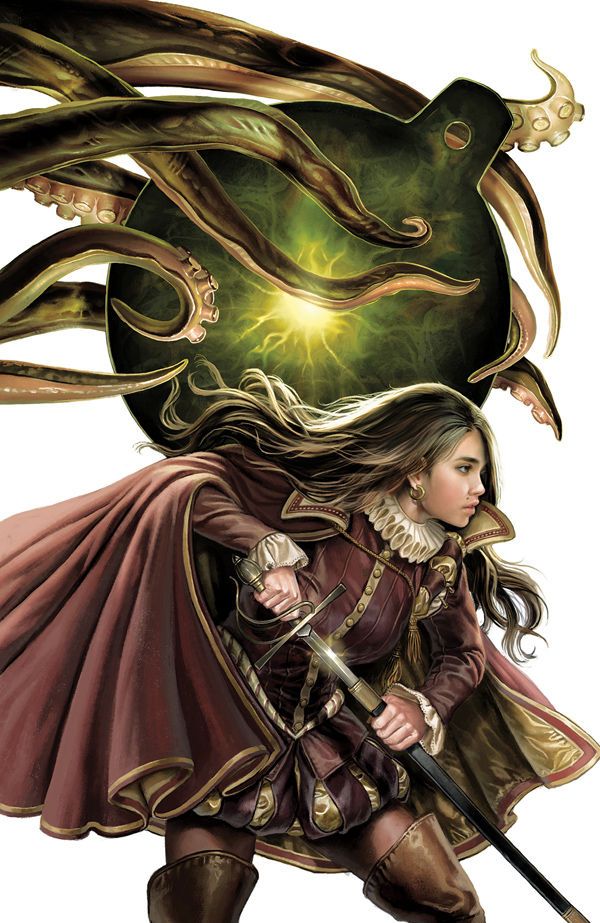In the prologue of "The Shadow Glass" #1, Aly Fell introduces Thomas Hughes, but the perspective and the readers' sympathies quickly shift to Arabella and then settle for good on the main character, Rosalind. It's unexpected to open the story with the villain, but -- after that -- there are few surprises. "The Shadow Glass" #1 simply strings together well-worn tropes: an heirloom sword, a conveniently dying guardian and a birth secret.
Adam's dialogue about Rosalind's origin has some emotional force to it. His speech comes the closest to capturing natural rhythms of speech, but the whole scene is still an expository information dump. The silent sequence where Rosalind passes by a gallows is more skillful, although a whole two pages are used to show that the heroine has a tender heart and accomplishes little else than to reinforce the setting.
The action of the plot is driven by Rosalind's parentage, but it makes no sense for Adam to drop a bomb and then immediately order Rosalind not to look for Thomas Hughes. Fell doesn't explain why Adam believes it necessary for Rosalind to learn about her parentage before he passes away, and it's also a mystery why he let her have so much contact with Dr. Dee or why he still trusts Dee after what happened to Arabella. The foundation of the plot feels neither original nor well thought-out, and Fell also fails to generate suspense about Rosalind's inevitable convergence with her biological father.
Dr. John Dee, based on the historical figure, plays the Nice Guy in contrast to Thomas and acts as Rosalind's mentor. However, he's also ultimately unsympathetic, more interested in knowledge than in morality. Dee proceeds to use Arabella in the face of her obvious distress and merely nominal acquiescence, making him either a fool or a villain.
Adam, not Rosalind, is the most sympathetic character so far. Rosalind reacts like a child to bad news, and she doesn't show enough intelligence to make her immaturity more palatable. Fell wants to show a "spirited" heroine with a big heart, but Rosalind ends up coming across as melodramatic, impetuous and headstrong. Rebelliousness and independence in a character without evidence of good judgment or cunning is often just irritating. Rosalind doesn't measure up yet to her Shakespearean namesake.
Fell's artwork is stronger than his writing. The opening full-page spread is a riverside scene in 16th century London, and Fell's use of light and gentle shades of blue and green in the background are reminiscent of a Turner watercolor painting. Throughout "The Shadow Glass" #1, the architectural and sartorial details are impressive. He also has an admirable range in drawing many different kinds of bodies and facial shapes.
Fell's story is superficially feminist. "The Shadow Glass" #1 stars a cross-dressing young heroine who is "self-reliant" and wields a sword, but his artwork sends mixed messages by relentlessly sexualizing the conventionally attractive mother and daughter, one a victim, the other the putative heroine who is supposed to escape her mother's fate. Arabella and Rosalind's facial expressions and gestures, how they move and position their limbs and speak the languages of allurement and submission are so suggestive that they look like they're straight out of shampoo or lingerie ads. This distracts from the plot, and -- more to the point -- it doesn't match up well with the dialogue or characterization. The sexuality is there when Arabella looks upward beseechingly or when Rosalind undoes her braid, but Fell goes beyond the subtle when he has Rosalind undress in front of the reader. While it may be necessary to have Rosalind change into a dress, it doesn't serve the story to show her naked backside.
Fell's artistic skills are obvious in the backgrounds and delicate color work, but his facial expressions and body language -- which are more important in sequential storytelling -- don't adequately support the story, which is weak on plotting and characterization.

